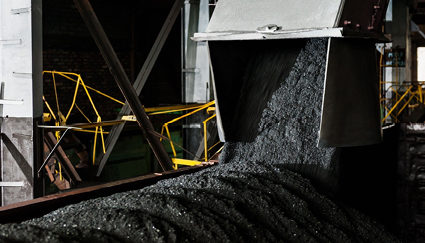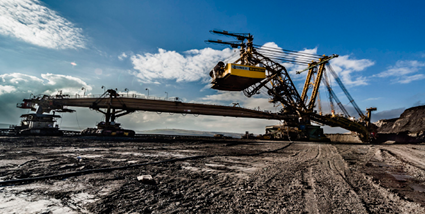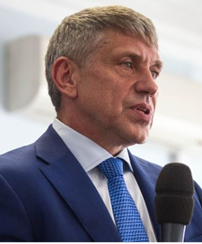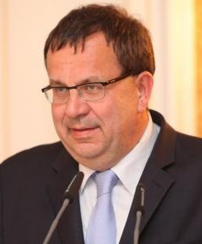The first half of 2016 has not gone well for the largest coal producers in eastern Europe: Ukraine’s DTEK, Poland’s Kompania Weglowa and the Czech Republic’s OKD. Each are leading coal producers in their respective countries, and they are all facing financial difficulties as production costs exceed current market prices. All of these coal operators are urging authorities to expand subsidies until prices move higher to avoid bankruptcy and a further collapse of this industrial segment.
Miners check for gas at the Dolzhanskaya-Kapitalnaya mine in Ukraine. (Photo courtesy of DTEK, 2014)
Ultimately, however, it turns out that each country has its own attitude toward the future for coal producers. The Czech Republic, which relies on brown coal production for power generation, will not support OKD’s metallurgical coal mines. Poland has reorganized again, but this time it will have to make tough choices or it will simply end up in the same position in two years and further in debt. With the war and the new Russian republics, the situation in Ukraine remains uncertain. The country hopes to avoid buying coal or gas from Russia, yet it has had to buy coal from rebel-held mines to avoid an energy crisis.
What is clear is that coal production at some of the deeper operations will end soon. The bigger question is whether the countries are prepared for the loss in gross domestic production (GDP) and the socioeconomic impact of the loss of jobs. And then there are the legacy issues, such as retired miners and environmental cleanup that will also have to be addressed.
Ukraine Imports Coal for the First Time
The largest coal producer in Ukraine is DTEK and it has six subsidiaries: Pavlogradugol (10 mines), Dobropolyeugol (five mines), Rovenkianthracite (six mines), Sverdlovanthracite (five mines), Komosomolets Donbassa (one mine) and ALC Bilozerska (one mine). The company also operates 12 prep plants.
Last year, DTEK experienced a 90% increase in losses compared to 2014 to $1.4 billion. In response, the Fitch agency has lowered the company’s rating from CCC to C, indicating significant problems and creating quite a bit of speculation on possible bankruptcy. Despite huge losses, DTEK executives have close ties to Ukraine’s government, which they hope will improve situation.
Ukraine’s government has initiated a painful reform for the coal industry, with the goal of not only cutting its losses related to DTEK, but also for coal equipment manufacturers by ending subsidies. Today, Ukraine spends UAH 13 billion ($520 million) annually to support coal mining operations and a new plan put forward by the country’s ministry of energy and coal calls to significantly cut this figure by 2020.
According to former Energy Minister Vladimir Demchishin, subsidies previously allowed Ukraine to maintain one of Europe’s lowest energy tariffs. In May, new Minister Igor Nasalik said he believed prices for coal would rise in the coming years, but offered no figures to support this view.
With the rise of energy tariffs by nearly 60% since the beginning of the crisis, some experts said Ukraine should set the minimum price for coal at UAH 2,000 per metric ton (or $78/mt), increasing it nearly 30% compared to the current level. By 2020, the price could be raised to UAH 2,500/mt ($98/mt), decreasing the share of loss-making mines in the country from nearly 65% to only 5%-10%. DTEK, in particular, would post significant profits in this scenario.
Since 2013, Ukraine has lost its position as a net coal exporter with production falling from 86 million mt in 2012 to less than 40 million mt in 2015. For the first time in its history, Ukraine imported coal, spending almost $1 billion to avoid an energy crisis.
New reform seems to be part of an energy-independence doctrine of Ukraine President Petro Poroshenko who wants to avoid purchasing gas and coal from Russia or at least cut it to its lowest possible level. The country’s government lacks the available funds and, with its obligations to the International Monetary Funds (IMF), it could no longer support the coal industry as it has for the last two decades.
The new reforms also include large-scale privatization. Of the 35 operating state-owned mines, the country’s Ministry of Energy and Coal is going to sell 15 and close 11.
During the first quarter of 2016, Ukrainian coal production rose 12.6% to 10 million mt over the same period last year. Of this figure, 7.2 million mt were produced by DTEK. During 2015, Ukraine’s total coal production dropped 54.3% to 29.7 million mt, following a 22% drop in 2014 to 65 million mt. This year, Ukraine could produce as much as 41 million mt of coal, which would almost meet its domestic demand.
Since the beginning of the armed conflict in Donetsk and Luhansk Oblast, Kiev has lost access to the coal mines in the region controlled by the pro-Russian rebels. The country’s energy ministry during the last two years has had to purchase coal from the rebel mines, despite the war. Still, according to Ukraine Energy Ministry Igor Nasalik, each year Kiev purchases up to 4 million mt of coal from rebel territories at the average price of only $600/mt to $700/mt.

DTEK has six subsidiaries, 28 mines and 12 prep plants. (Photo courtesy of DTEK, 2014)
He added that this is mostly a social move, as “Ukraine cannot let local miners die from hunger.” In reality, Ukraine has no choice, which was demonstrated in 2015 when it purchased “experimental” coal from Poland and Russia. It turned out that imported coal had too much ash and an inappropriate calorific value for local plants, which were designed to burn coal for the Donetsk region.
As the result, according to Mikhail Volynets, the head of the country’s miners’ labor union, it resulted in an acute deficit of coal at the thermal power plants and nearly lead to the collapse of Ukraine’s energy industry in mid-2015.
Production data from the mines controlled by rebels is hard to find. Prior to the crisis, these mines accounted for 30 million mtpy of coal production, while it’s believed they are mining 14 million mtpy. According to regional officials, last year, one of two rebel republics — the so-called Donetsk New Republic (DNR) — produced 9.5 million mt of coal, while this year is going to increase this figure to 13.5 million mt. Production data from the Luhansk New Republic (LNR) is unreliable and estimated at 4.5 million mtpy.
Both the DNR and LNR spend about 6 million mt of coal for the needs of local consumers and export 4 million mt to Ukraine. Where the remaining 4 million to 5 million mt or even more is sold is unclear. Some Ukraine officials claim this amount is illegally exported by truck to Russia, while others believe it is sold to Ukraine on the black market.
PPG Takes Over Production in Poland
As of May 1, within an agreement between banks, and mining and energy companies, Polska Grupa Górnicza (the Polish Mining Group or PGG) will take over 11 coal mines and four Kompania Weglowa establishments as well as the entire workforce of approximately 30,000 employees. With a total production capacity of about 40 million mt of coal, PGG will become the largest European coal producer.

A miner cuts coal at one of Weglowa’s longwall mines in Poland. (Photo courtesy of Kompania Weglowa)
Poland’s total coal production last year amounted to 72.2 million mt, a slight decrease compared to 2014. The Polish government expects that figure to drop to 45.5 million mt by 2020. At the same time, the Katowice Agency for Industrial Development estimated last year’s losses at PLZ 1.9 billion ($481 million), which is PLZ 150 million ($38 million) less than 2014. The average loss per ton of coal was PLZ 26.81/mt ($6.8/mt), while the industry’s debt climbed to PLZ 14.7 billion ($3.72 billion).
Most of the losses were compiled by Kompania Weglowa, which have put the Polish coal industry on the brink of bankruptcy since the beginning of 2016. A new agreement designed to save the business combined nine adjacent mines into three mining complexes consisting of two to four mines each to reduce operating costs and simplify the corporate structure. The remaining two mines will continue their operations independently.
At the beginning of April, Kompania Weglowa’s debt totaled PLZ 8.5 billion ($2.15 billion). The three largest Poland energy companies already declared their willingness to pump PLZ 1.5 billion ($379 million) into PGG, while the energy ministry promised support in restructuring of company’s debts of PLZ 500 million ($126 million) on bank loans.
Last year, Poland’s three biggest mining firms, including Kompania Weglowa, KHW and JSW as well as the three state-run power producers, which burn the coal, posted a net loss of almost PLZ 10 billion ($2.6 billion). With the depth of extraction reaching 1,300 m in some parts of Silesia, some officials said it’s time to give up. The government, however, is not giving up on the industry, supporting the new agreement and indicating that coal still accounts for 85% of its power generation.

The Bilina mine is the largest open-cut lignite mine in Central Europe. (Photo courtesy of Severoceske doly)
According to the Polish government’s plans, the remainder of Kompania Weglowa’s debt will be distributed over at least seven years. At the same time, the goal is to improve the profitability of the company. For instance, last year, only three of Kompania Weglowa’s 11 mines were profitable. The plan also considers mining new deposits with better coal quality, management improvements, entering a six-day work week and suspending bonuses to miners for two years.
Despite these measures, the future of the Polish coal industry remains unclear. According to Michael Vilchinsky, former chief national geologist and former deputy environmental minister, Poland’s coal on the open market would currently sell for $45/mt, while production costs average $65/mt and there is no sign the prices will improve anytime soon.
Once taxes and transportation are factored into the mix, some mines are producing coal at a loss of PLZ 120/mt ($30/mt). According to Vilchinsky, the future of at least five out of 11 PGG coal mines remains uncertain. He said the industry should focus on the most profitable assets and discontinue loss-making production.
Andrei Barzhak, an economics professor at the University in Katowice, suggested that new PGG management should be willing to conduct real reforms and close unprofitable assets to reduce the supply for the domestic market and improve prices. Simply injecting more money, in his opinion, with no real actions to improve profitability means that PGG will face the same financial fate as Kompania Weglowa two years from now.
At the same time, the report from Warsaw Institute of Economic Studies (WiseEuropa) suggested that PGG should conduct large-scale restructuring, cutting the volume of coal mining by 40% or 16 million mt and dismiss up to 50% of staff or 15,000 employees. Otherwise, PGG risks bankruptcy or applying for more large-scale subsidies, according to Mazei Bukowski, president of WiseEuropa. At the same time, huge political and socioeconomic risks could make implementation of real reforms impossible.
Despite the heavy poor market conditions, Poland’s coal industry still may have another new, huge project come online as Australian Prairie Mining in 2017 is going to apply for a license to construct the Jan Karsky mine in the Lubelskim coal basin. With an overall investment of $632 million, it is expected to produce 6.3 million mt of coal and employ 2,000. The average cost of production here would be $25/mt, almost three times lower than PGG mines.
The reserves of the licensed area, estimated at 700 million mt, are enough to maintain mining for at least 25 years. Some officials have already declared this deposit as the biggest undeveloped coalfield in Europe. As Ben Stoikovitch, CEO of Prairie Mining, explained, his company plans to export most of the coal and he sees huge potential for the European coal market, as it still consumes nearly 700 million mtpy. Germany alone accounts for 230 million mtpy.
For now, PPG will focus on the domestic market and export some coal to nearby countries. With the insolvency of Czech coal producer OKD, several Czech steel producers have been talking to PPG about sustaining their supply.
Czech Republic Not Supporting OKD
The situation in the Czech Republic is more complicated. With a debt of CZK 17 billion ($700 million), the largest coal producer OKD filed a petition for insolvency. Unlike Ukraine and Poland, the Czech government hasn’t shown much of an intention to save the coal mining jobs. The Czech Minister of Industry Jan Mladek, speaking about the OKD situation, has stated that it is clear that coal mining in Ostrava (the main coal producing region) will end. The only question he said is: “When it will take place? It could be 2020, 2022 or 2024.” He explained that the government should now make a gradual shift away from coal over this period.
Czech Prime Minister Bohuslav Sobotka supports Mladek and has expressed a willingness to fund requalification programs for the 13,000 miners whose jobs are now at risk. In general, the Czech government is prepared for the possible closure of coal mines, as its recent forecast indicated the reduction of coal’s share in electricity generation from 52% today to 30.5% in 2030.
OKD, however, mines 11 million mtpy of metallurgical coal, which is consumed by the country’s steel industry. These mines have now reached a depth of 1,270 m (4,167 ft) with production costs running as high as $70/mt. These excessive production costs led to large losses for OKD. In 2014, it applied to restructure debt with the gradual closing of the Paskov mine and the introduction of cost-reducing technologies at other mines. The insolvency petition will likely put an end to implementation of the debt restructuring program and the company’s operation. Since the middle of May, the Czech government has refused to inject funds into the company’s operations, despite the fact that the collapse of OKD could cost Czech Republic 0.4% of GDP and a loss of approximately $1.5 billion.
Part of problems for OKD is associated with environmental policy. The government established environmental mining limits in 1991 which currently prevent access to over 1 billion mt of coal. The restrictions prevent the extension of existing mineable areas and preclude the opening of new mines to protect villages and towns from being affected by mining activities. Lifting the restrictions could give the country’s mining companies access to low-cost reserves.
In October 2015, the Czech government agreed to expand the mining area for Bilina mine near Teplicku, which should significantly improve the situation for the Czech Republic’s largest lignite producer, Severoceské doly. Together the Bilina mine, which is the largest open-cut mine in Central Europe, and the Tusimice mine currently produce 23 million mtpy of lignite, which is burned by power plants.
Czech mining companies are exploring for new deposits, particularly along the Czech-Polish border where an agreement has been drawn up between the countries to allow for coal exploration. This is in anticipation of the lifting of the current mining restrictions in this area.
The companies are also evaluating the possibility of re-opening closed mines through application of modern efficient mining methods. The existing mines have in recent years modernized operations by investing in conveyor systems and slurry management. Two new filter presses were recently installed for dewatering refuse.
 |
 |
| Igor Nasalik, Ukraine’s energy minister. | Jan Mladek, minister of industry, Czech Republic. |
The decision by Czech authorities to lift limits has been welcomed by the lignite mining industry, which believes it will open access to 120 million mtpy of brown coal. Theoretically, Severoceské doly would be able to operate until 2055, producing 9.7 million mtpy of lignite from this region at one of the most competitive prices in Europe.
A similar decision awaits the Czech Coal Group in regard to its two mines Litvinovska uhelna and Vrsanska uhelna. Litvinovska uhelna owns a license to mine one of the largest high-quality brown coal reserves in the Czech Republic. The reserve boasts 24 million mt with an average calorific value of 17.5 MJ/kg. It is part of a much larger reserve, estimated at 750 million mt of lignite, but mining in this area is prohibited by environmental policy.






